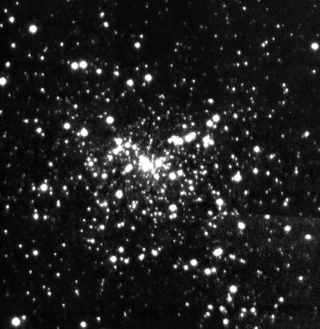Twinkling, also called scintillation, is a generic term for variations in apparent brightness, colour, or position of a distant luminous object viewed through a medium. [1] If the object lies outside the Earth's atmosphere, as in the case of stars and planets, the phenomenon is termed astronomical scintillation; for objects within the atmosphere, the phenomenon is termed terrestrial scintillation. [2] As one of the three principal factors governing astronomical seeing (the others being light pollution and cloud cover), atmospheric scintillation is defined as variations in illuminance only.
In simple terms, twinkling of stars is caused by the passing of light through different layers of a turbulent atmosphere. Most scintillation effects are caused by anomalous atmospheric refraction caused by small-scale fluctuations in air density usually related to temperature gradients. [3] [4] Scintillation effects are always much more pronounced near the horizon than near the zenith (directly overhead), [5] since light rays near the horizon must penetrate a denser layer of and have longer paths through the atmosphere before reaching the observer. Atmospheric twinkling is measured quantitatively using a scintillometer. [6] The effects of twinkling are reduced by using a larger receiver aperture; this effect is known as aperture averaging. [7] [8]
While light from stars and other astronomical objects is likely to twinkle, [9] twinkling usually does not cause images of planets to flicker appreciably. [10] [11] Stars twinkle because they are so far from Earth that they appear as point sources of light easily disturbed by Earth's atmospheric turbulence, which acts like lenses and prisms diverting the light's path. Large astronomical objects closer to Earth, like the Moon and other planets, encompass many points in space and can be resolved as objects with observable diameters. With multiple observed points of light traversing the atmosphere, their light's deviations average out and the viewer perceives less variation in light coming from them. [12] [13]

A space telescope or space observatory is a telescope in outer space used to observe astronomical objects. Suggested by Lyman Spitzer in 1946, the first operational telescopes were the American Orbiting Astronomical Observatory, OAO-2 launched in 1968, and the Soviet Orion 1 ultraviolet telescope aboard space station Salyut 1 in 1971. Space telescopes avoid the filtering and distortion (scintillation) of electromagnetic radiation which they observe, and avoid light pollution which ground-based observatories encounter. They are divided into two types: Satellites which map the entire sky, and satellites which focus on selected astronomical objects or parts of the sky and beyond. Space telescopes are distinct from Earth imaging satellites, which point toward Earth for satellite imaging, applied for weather analysis, espionage, and other types of information gathering.

The green flash and green ray are meteorological optical phenomena that sometimes occur transiently around the moment of sunset or sunrise. When the conditions are right, a distinct green spot is briefly visible above the Sun's upper limb; the green appearance usually lasts for no more than two seconds. Rarely, the green flash can resemble a green ray shooting up from the sunset or sunrise point.

A mirage is a naturally-occurring optical phenomenon in which light rays bend via refraction to produce a displaced image of distant objects or the sky. The word comes to English via the French (se) mirer, from the Latin mirari, meaning "to look at, to wonder at".

A meteoroid is a small rocky or metallic body in outer space. Meteoroids are distinguished as objects significantly smaller than asteroids, ranging in size from grains to objects up to a meter wide. Objects smaller than meteoroids are classified as micrometeoroids or space dust. Most are fragments from comets or asteroids, whereas others are collision impact debris ejected from bodies such as the Moon or Mars.

A polar circle is a geographic term for a conditional circular line (arc) referring either to the Arctic Circle or the Antarctic Circle. These are two of the keynote circles of latitude (parallels). On Earth, the Arctic Circle is currently drifting northwards at a speed of about 14.5 m per year and is now at a mean latitude of 66°33′49.9″ N; the Antarctic Circle is currently drifting southwards at a speed of about 14.5 m per year and is now at a mean latitude of 66°33′49.9″ S. Polar circles are often equated with polar regions of Earth. Due to their inherent climate environment, the bulk of the Arctic Circle, much of which is sea, is sparsely settled whereas this applies to all of Antarctica which is mainly land and sheltered ice shelves.

Sunrise is the moment when the upper rim of the Sun appears on the horizon in the morning. The term can also refer to the entire process of the solar disk crossing the horizon.

The atmosphere of Earth is the layer of gases, known collectively as air, retained by Earth's gravity that surrounds the planet and forms its planetary atmosphere. The atmosphere of Earth creates pressure, absorbs most meteoroids and ultraviolet solar radiation, warms the surface through heat retention, and reduces temperature extremes between day and night, maintaining conditions allowing life and liquid water to exist on the Earth's surface.

Photometry, from Greek photo- ("light") and -metry ("measure"), is a technique used in astronomy that is concerned with measuring the flux or intensity of light radiated by astronomical objects. This light is measured through a telescope using a photometer, often made using electronic devices such as a CCD photometer or a photoelectric photometer that converts light into an electric current by the photoelectric effect. When calibrated against standard stars of known intensity and colour, photometers can measure the brightness or apparent magnitude of celestial objects.

In astronomy, seeing is the degradation of the image of an astronomical object due to turbulence in the atmosphere of Earth that may become visible as blurring, twinkling or variable distortion. The origin of this effect is rapidly changing variations of the optical refractive index along the light path from the object to the detector. Seeing is a major limitation to the angular resolution in astronomical observations with telescopes that would otherwise be limited through diffraction by the size of the telescope aperture. Today, many large scientific ground-based optical telescopes include adaptive optics to overcome seeing.

Speckle imaging comprises a range of high-resolution astronomical imaging techniques based on the analysis of large numbers of short exposures that freeze the variation of atmospheric turbulence. They can be divided into the shift-and-add method and the speckle interferometry methods. These techniques can dramatically increase the resolution of ground-based telescopes, but are limited to bright targets.

Observational astronomy is a division of astronomy that is concerned with recording data about the observable universe, in contrast with theoretical astronomy, which is mainly concerned with calculating the measurable implications of physical models. It is the practice and study of observing celestial objects with the use of telescopes and other astronomical instruments.

In astronomy, an extraterrestrial sky is a view of outer space from the surface of an astronomical body other than Earth.

Lucky imaging is one form of speckle imaging used for astrophotography. Speckle imaging techniques use a high-speed camera with exposure times short enough so that the changes in the Earth's atmosphere during the exposure are minimal.

A scintillometer is a scientific device used to measure turbulent fluctuations of the refractive index of air caused by variations in temperature, humidity, and pressure. It consists of an optical or radio wave transmitter and a receiver at opposite ends of an atmospheric propagation path. The receiver detects and evaluates the intensity fluctuations of the transmitted signal, called scintillation.

Atmospheric refraction is the deviation of light or other electromagnetic wave from a straight line as it passes through the atmosphere due to the variation in air density as a function of height. This refraction is due to the velocity of light through air decreasing with increased density. Atmospheric refraction near the ground produces mirages. Such refraction can also raise or lower, or stretch or shorten, the images of distant objects without involving mirages. Turbulent air can make distant objects appear to twinkle or shimmer. The term also applies to the refraction of sound. Atmospheric refraction is considered in measuring the position of both celestial and terrestrial objects.
The apparent place of an object is its position in space as seen by an observer. Because of physical and geometrical effects it may differ from the "true" or "geometric" position.

Shadow bands are thin, wavy lines of alternating light and dark that can be seen moving and undulating in parallel on plain-coloured surfaces immediately before and after a total solar eclipse. They are caused by the refraction by Earth's atmospheric turbulence of the solar crescent as it thins to a narrow slit, which increasingly collimates the light reaching Earth in the minute just before and after totality.

The atmosphere of Pluto consists mainly of nitrogen (N2), with minor amounts of methane (CH4) and carbon monoxide (CO), all of which are vaporized from their ices on Pluto's surface. It contains layered haze, probably consisting of heavier compounds which form from these gases due to high-energy radiation. The atmosphere of Pluto is notable for its strong and not completely understood seasonal changes caused by peculiarities of the orbital and axial rotation of Pluto.
This glossary of astronomy is a list of definitions of terms and concepts relevant to astronomy and cosmology, their sub-disciplines, and related fields. Astronomy is concerned with the study of celestial objects and phenomena that originate outside the atmosphere of Earth. The field of astronomy features an extensive vocabulary and a significant amount of jargon.
Stellar chemistry is the study of chemical composition of astronomical objects; stars in particular, hence the name stellar chemistry. The significance of stellar chemical composition is an open ended question at this point. Some research asserts that a greater abundance of certain elements in the stellar mass are necessary for a star's inner solar system to be habitable over long periods of time. The hypothesis being that the "abundance of these elements make the star cooler and cause it to evolve more slowly, thereby giving planets in its habitable zone more time to develop life as we know it." Stellar abundance of oxygen also appears to be critical to the length of time newly developed planets exist in a habitable zone around their host star. Researchers postulate that if our own sun had a lower abundance of oxygen, the Earth would have ceased to "live" in a habitable zone a billion years ago, long before complex organisms had the opportunity to evolve.